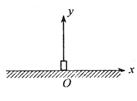问题
单项选择题
许多民族都有在冬天的节日里烘烤食物的传统,这种传统的形成有医学上的根据。在隆冬季节,白天很短,许多人由于缺少太阳光照,精神上变得抑郁,现代医学把这称为季节性抑郁。烘烤食物中的碳水化合物(粮和淀粉)提升了大脑中的血清素含量,这是一种能改善人情绪的神经介质。这里,碳水化合物对于大脑的作用方式和现在的某些抗抑郁药物是一样的。因此,享受节日中的口福很可能是一种有效的自我医疗。
以上陈述能推出以下哪项结论
A.季节性抑郁是一种最易治愈的抑郁症。
B.缺少太阳光照导致了大脑中血清素含量的减少。
C.和一年中其他季节相比,人最容易在隆冬季节产生抑郁。
D.某些抗抑郁药物通过改变血清素的含量来影响大脑。
E.大多数喜欢吃烘烤食物的人精神并不抑郁。
答案
参考答案:D

 的匀强电场。一个质量
的匀强电场。一个质量 、电量
、电量 的带正电的物块(可作为质点),从O点开始以v0=10.0m/s的初速度沿着X轴正方向做直线运动,物块与水平面间动摩擦因数
的带正电的物块(可作为质点),从O点开始以v0=10.0m/s的初速度沿着X轴正方向做直线运动,物块与水平面间动摩擦因数 =0.5,g=10m/s2。
=0.5,g=10m/s2。
 。
。